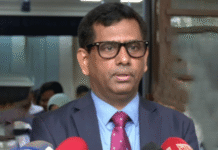Govt statistics show number of hospitalised, critical patients on rise; experts say social distancing not possible in public transports
The numbers of Covid-19 patients at the hospitals and those needing treatment at Intensive Care Units have increased over the last one month, suggesting that there is still a long way to go to bring the pandemic under control.
At least 4,022 Covid-19 patients were admitted at hospitals on August 2. Of them, some 283 in critical conditions were being treated at the Intensive Care Units (ICU).
One month down the line, when things appear to be returning to normalcy, the number of hospitalised patients was 4,049; and 300 of them were in ICUs on Tuesday.

Although there is no sign of the pandemic abating anytime soon, the government has lifted all restrictions on public movement and activities which were imposed to contain the spread of coronavirus.
Besides, the government also allowed public transport to operate at capacity from Tuesday.
Health experts maintain that it cannot be said that the outbreak has come under control until the positivity rate falls below 5 percent, and a temporary trend of decline in the positivity rate might stumble through the lifting of restrictions.
Buy elavil online
“I don’t understand why the government took the decision. They should let people know the logic behind such a move,” noted virologist Prof Nazrul Islam told The Daily Star.
In the first phase of Covid-19 transmission, the government implemented only a part of the containment strategy formulated by health experts. It later experimented with marking and “locking down” zones in two areas in the capital and in several districts.
And the last visible step to contain the coronavirus was seen in July.
In the absence of any strict containment strategy, the country has been witnessing a high number of deaths since last month.
Twenty-two people died from the virus on August 2 and the number was 35 on Tuesday.
The overall positivity rate came down to 20.16 percent from 24.05 percent on August 2. But the rate was still much higher than the global average.
Despite the alarming numbers, the need for controlling the virus apparently became a secondary concern for the government as most of its activities revolved around reviving the battered economy.
HAS THE SITUATION IMPROVED?
According to a report the health ministry sent to the Prime Minister’s Office on Tuesday, a total of 43 Covid-19-dedicated hospitals had 14,847 general beds and 550 ICU ones.
A total of 3,749 Covid-19 patients were in general beds and 300 others in ICU ones on Tuesday, according to the report.
Of the patients at general beds, the highest, 2,306, are from Dhaka division, including 2,079 from Dhaka city alone. In Chattogram division, there were 637 hospitalised patients.
A total of 427 patients got admitted to the hospitals on Tuesday and 516 got released, according to the report.
Prof Nazrul Islam, also a member of the National Technical Advisory Committee on Covid-19, said the government did not take the committee’s suggestions into consideration before making decision to normalsie public transport operations.
The government must have taken the decision to ease people’s woes, but the health safety guidelines were ignored.
“So, there is a likelihood for further transmission of the virus, because it is not possible to maintain physical distancing on public transport,” said the former vice chancellor of Bangabandhu Sheikh Mujib Medical University.
The government should have taken steps while keeping in mind that people tend to violate health safety rules. “The government’s duty does not end with issuing guidelines. It has to monitor whether the guidelines are being followed.”
On the decline in positivity rate, he said, “We have to wait for some more days to know whether the positivity rate has declined actually or it is because of the low number of tests.”
The desired rate of under-5 percent is still a long way to go, he added.
Prof Muzaherul Huq, a former adviser of World Health Organization’s South East Asia region, said Bangladesh is still among the countries where the transmission rate is high.
“Lifting of restrictions from public transport was a risky move,” he told The Daily Star on Monday.
He said the positivity rate in Bangladesh is still above 20 percent.
“Therefore, the health safety guidelines, particularly the physical distancing, applied for public transport should not be relaxed right now,” he said, adding, “If the physical distancing is relaxed in public transport, transmission would definitely rise.”
Buy effexor online









